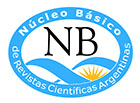A Systemic Analysis of the Growth of Biotechnological Activity in Argentina (1982-2022)
Keywords:
Biotechnology, Innovation, Argentina, Productive Development, Innovation SystemAbstract
This article offers a historical overview of the growth of biotechnology activity in Argentina from the 1980s to the present. The objective is to contribute to a better understanding of the transformation, on the one hand, of the productive structure, in terms of the types of companies and the technological and productive capabilities that have been developed in the country, and, on the other hand, of the innovation system (in terms of actors, linkages and institutions) associated with the construction of endogenous capabilities in this activity. The article is based on a bibliographic review of studies and measurements of entrepreneurial activity in biotechnology in Argentina and on a fieldwork study to firms, science and technology institutions, accelerators, chambers and experts in the sector. The analysis identifies three periods in the development of entrepreneurial activity in biotechnology in Argentina, each one characterized by the predominance of specific micro and meso economic dynamics. During the period of analysis the sectoral innovation system has become more complex in terms of the number and type of actors involved and their links with the productive sector. The article identifies the main features of the development of the biotechnology activity in this country and raise questions regarding its dynamics and future growth.
Downloads
References
Aguiar, D. y Thomas, H. (2009). Historia de los antecedentes a la creación de una empresa de biotecnología orientada a la salud en la Argentina: El “Área de Biotecnología” de Sidus (1980-1983). Revista de Humanidades Médicas & Estudios Sociales de la Ciencia y la Tecnología, 1(2), 3-44.
Ahuja, G. (2000). Collaboration networks, structural holes and innovation: A longitudinal study. Administrative Science Quarterly, (45), 425-455.
Anlló, G., Bisang, R., y Stubrin, L. (2011). Las empresas de biotecnología en Argentina. CEPAL.
Arora, A. y Gambardella, A. (1994). Complementarity and external linkages: The strategies of large firms in biotechnology. Journal of Industrial Economics, (38), 361-379.
Breschi, S., y Malerba, F. (1997). Sectoral innovation systems: technological regimes, Schumpeterian dynamics, and spatial boundaries. Systems of innovation: Technologies, institutions and organizations, (1), 130-156.
Bergeron, B., y Chan, P. (2004). Biotech industry: A global, economic, and financing overview. Nueva Jersey: John Wiley & Sons.
Bisang, R. (2003). Apertura económica, innovación y estructura productiva: la aplicación de biotecnología en la producción agrícola pampeana argentina. Desarrollo Económico, Revista de Ciencias Sociales, 43(171), 413-442.
Bisang, R., Gutman, G., Lavarello, P., Sztulwark, S. y Díaz, A. (2006). Biotecnología y desarrollo. Un modelo para armar en la Argentina. Buenos Aires: Universidad Nacional de General Sarmiento.
Bisang, R., Campi, M., y Cesa, V. (2009). Biotecnología y desarrollo. Buenos Aires: CEPAL.
Bisang, R. y Stubrin, L. (2010). Las empresas de biotecnología en la Provincia de Santa Fe. Buenos Aires: CEPAL.
Bortz, G. y Gázquez, A. (2020). Políticas CTI en Argentina durante la pandemia: ¿oportunidad para nuevas redes participativas en I+D+i? Debates sobre Innovación, 5(1), 16-23.
Brookes, G., y Barfoot, P. (2009). Global impact of biotech crops: Income and production effects, 1996–2007. AgBioForum, (12), 184–208.
Brookes, G., y Barfoot, P. (2018). Farm income and production impacts of using GM crop technology 1996–2016. GM Crops Food, 9(2),59-89.
Brüssow, H. (2022). mRNA vaccines against COVID‐19: a showcase for the importance of microbial biotechnology. Microbial Biotechnology, 15(1), 135-148.
Buschini, J., y Di Bello, M. (2015). Emergencia de las políticas de vinculación entre el sector científico-académico y el sector productivo en la Argentina (1983-1990). Redes, 20(39), 139-158.
Ciccia G. (2020). Un antes y después para el desarrollo científico y tecnológico. En R. Agosta et al. (comp.), Pospandemia: 53 políticas públicas para el mundo que viene (pp. 18-21). Buenos Aires: CEPE.
Codner, D., Martin, D., Pellegrini, P., Becerra, P., y Baudry, G. (2015). Las Oficinas de Transferencia Tecnológica en Argentina: estrategias y canales. En C. Garrido Noguera, y N. Rondero López (coords.), Oficinas de transferencia tecnológica (pp. 23-42). Ciudad de México: Unión de Universidades de América Latina y el Caribe.
Friedrichs, S. (2018). Report on statistics and indicators of biotechnology and nanotechnology. Paris: OECD.
Gilding, M. (2008). ’The tyranny of distance’: Biotechnology networks and clusters in the antipodes. Research Policy, 37(6-7), 1132-1144.
Gutman, G., y Lavarello, P. (2007). Biotecnología y desarrollo. Avances de la agrobiotecnología en Argentina y Brasil. Economía teoría y práctica, (27), 5-35.
Gutman, G., & Lavarello, P. (2011). Formas de organización de las empresas biotechnológicas en el sector farmacéutico argentino. Desarrollo Económico. Revista de Ciencias Sociales, 51(201), 81-105.
Gutman, G., y Lavarello, P. J. (2014). Innovación y Desarrollo en el Sector Biofarmacéutico en Argentina. Estudios de caso. En G. Gutman y P. Lavarello (eds.), Biotecnología Industrial en Argentina. Estrategias empresariales frente al nuevo paradigma (pp. 153-188). Buenos Aires: Gran Aldea Editores.
Gutman, G. E., y Lavarello, P. J. (2017). El sector biofarmacéutico: desafíos de política para una industria basada en la ciencia. En M. Abeles, M. Cimoli y P. Lavarello (eds.), Manufactura y Cambio Estructural: aportes para pensar la política industrial en la Argentina (pp. 243-281). Santiago: CEPAL.
Heimeriks, G., y Boschma, R. (2014). The path-and place-dep-endent nature of scientific knowledge production in biotech 1986–2008. Journal of Economic Geography, 14(2), 339-364.
Katz, J., y Bercovich, N. (1990). Biotecnología y economía política: estudios del caso argentino. Buenos Aires: CEPAL.
Kreimer, P. (2010). Ciencia y Periferia: nacimiento, muerte y resurrección de la biología molecular en la Argentina: aspectos sociales, políticos y cognitivos. Buenos Aires: Editorial Eudeba.
Malerba, F. (2002). Sectoral systems of innovation and production. Research policy, 31(2), 247-264.
Marin, A. y Stubrin, L. I. (2017). Oportunidades y desafíos para convertirse en un innovador mundial en Recursos Naturales: El caso de las empresas de semillas en Argentina. Desarrollo Económico. Revista de Ciencias Sociales, 56(220), 471-497.
Marin, A., Stubrin, L. I., y Roitbarg, R. P. (2022). Growing from the South in the seed market: Grupo Don Mario. Journal of Agribusiness in Developing and Emerging Economies, 12(4), 656-672.
MINCyT (2014). Las empresas de biotecnología en Argentina. Buenos Aires: MINCyT.
MINCyT (2016a). Las empresas de biotecnología en Argentina. Buenos Aires: MINCyT.
Anlló, G. et al. (2016b). Biotecnología Argentina al año 2030: llave estratégica para un modelo de desarrollo tecno-productivo. Buenos Aires: MINCyT.
MINCyT (2021). Encuesta I+D al sector empresario. Actividades biotecnológicas en Argentina. 2013-2019. Buenos Aires: MINCyT.
Niosi, J., y Reid, S. E. (2007). Biotechnology and nanotechnology: science-based enabling technologies as windows of opportunity for LDCs? World Development, 35(3), 426-438.
Friedrichs, S. y Van Beuzekom, B. (2018). Revised proposal for the revision of the statistical definitions of biotechnology and nanotechnology. Paris: OCDE.
Oliver, A. L. (2001). Strategic alliances and the learning life-cycle of biotechnology firms. Organization Studies, 22(3), 467-489.
Owen-Smith, J., Riccaboni, M., Pammolli, F., y Powell, W. W. (2002). A comparison of US and European university-industry relations in the life sciences. Management science, 48(1), 24-43.
Perticari, A., Piccinetti, C., Puente, M., García, J., y Rubio, E. (2009). Empleo de inoculantes microbianos en la producción de cereales y oleaginosas en Argentina: beneficios actuales y prospectiva. Buenos Aires: IMyZA.
Perticari, A., Basurco, J. P., y Benintende, G. (1994). Interacción entre diferentes inoculantes y temperaturas de almacenamiento sobre semilla preinoculada de soja. Actas de la XVIII Reunión Latinoamericana de Rhizobiología, La Habana, Cuba.
Pisano, G. P. (2006). Science business: The promise, the reality, and the future of biotech. Boston: Harvard Business Press.
Powell, W.W. y Brantley, P. (1992). Competitive cooperation in biotechnology: Learning through networks? En N. Nohria y R. Eccles (eds.), Networks and organizations (pp.366-394). Boston: Harvard Business Press.
Powell, W. W., Koput, K. W., Smith-Doerr L. y Owen-Smith, J. (1999). Network position and firm performance: Organizational returns to collaboration in the biotechnology industry. Networks in and around organizations, 16(1), 129-159.
Powell W. W., White, D. R., Koput, K. W. y Owen-Smith, J. (2005). Network dynamics and field evolution: The growth of inter-organizational collaboration in the life science, American Journal of Sociology, (110), 1132-1205.
Rees, K. (2005). Interregional collaboration and innovation in Vancouver’s emerging high-tech cluster, Tijdschrift voor Economische en Sociale Geografie, 96(3), 298-312.
Segers, J. P., y Gaile-Sarkane, E. (2021). Big pharma’s search for a COVID-19 vaccine: Take It To The Limit! Journal of Innovation Management, 9(2), I-VII.
Stubrin L. y Bisang, R. (2006). Derechos de propiedad intelectual y biotecnología: el ritmo asimétrico de patentamiento. En R. Bisang, G. Gutman, P. Lavarello, A. Díaz y S. Sztulwark (comp.), Biotecnología y desarrollo. Un modelo para armar en la economía argentina. Buenos Aires: Universidad Nacional de General Sarmiento.
Stubrin, L. (2012a). Biotecnología en la provincia de Santa Fe: el sector científico técnico. Buenos Aires: CEPAL.
Stubrin, L. (2012b). Mapa biotecnológico de la provincia de Córdoba. Buenos Aires: CEPAL.
Stubrin, L. (2013). High-tech activities in emerging economies. A network perspective on the Argentinean biotech activity (tesis de doctorado). Universitaire Pers Maastricht, Maastricht, Países Bajos.
Stubrin, L. (2019). Evolución, capacidades y perspectivas futuras de las empresas biotecnológicas argentinas. En P. Pellegrini (comp.). Biotecnología y emprendimientos: herramientas, perspectivas y desafíos (pp. 10-28). Buenos Aires: Universidad Nacional de Quilmes.
Trippl, M., y Tödtling, F. (2007). Developing Biotechnology Clusters in Non‐high Technology Regions: The Case of Austria. Industry and innovation, 14(1), 47-67.
Vale, M., y Carvalho, L. (2013). Knowledge networks and processes of anchoring in Portuguese biotechnology. Regional Studies, 47(7), 1018-1033.
Van Beuzekom, B. y Arundel A. (2009). Key biotechnology Statistics. Paris: OECD.
Verre, V., Milesi, D., y Petelski, N. (2017). Estrategias de apropiación en contextos de colaboración público-privada en la biotecnología argentina. Economía: teoría y práctica, (47), 31-64.
Zucker L., Darby M. y Brewer, M. (1998). Intellectual human capital and the birth of US biotechnology enterprises, American Economic Review, (88), 290-306.
Downloads
Published
How to Cite
Issue
Section
License

This work is licensed under a Creative Commons Attribution-NonCommercial-ShareAlike 4.0 International License.
Manuscript acceptance by the Journal implies the simultaneous non-submission to any other journal or publishing house, and the non-exclusive transmission of the author´s patrimonial rights in favor of the editor, who allows the post-print version use, under the Licencia Creative Commnos Atribución-NoComercial-Compartir Obras Derivadas Igual 4.0 Internacional (CC-BY-NC.SA 4.0) (http://creativecommons.org/licences/by-nc-sa/4.0/deed.es). Articles can be shared, copied, distributed, modified, altered, transformed into a derivative work, executed and publicly communicated, provided a) the authors and the original publication (Journal, Publisher and URL) are mentioned, b) they are not used for commercial purposes, c) the same terms of the license are maintained.
It is hereby stated that the mentioned manuscript has not been published and that it is not being printed in any other national or foreign journal.
The authors hereby accept the necessary modifications, suggested by the reviewers, in order to adapt the manuscript to the style and publication rules of this Journal.









